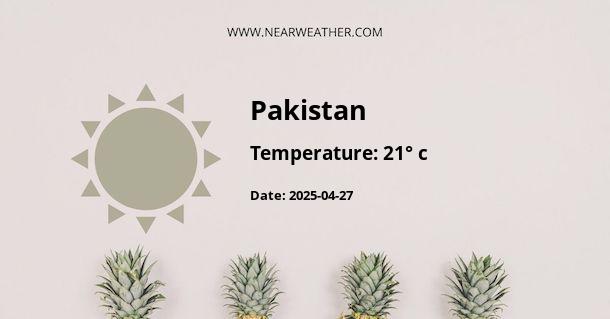Climate and Weather in the Islamic Republic of Pakistan
Pakistan, officially known as the Islamic Republic of Pakistan, is a country located in South Asia. It has a diverse climate and weather patterns, influenced by its geography, topography, and proximity to the Arabian Sea and the Himalayan mountain range. Let's explore the different regions of Pakistan and their unique climatic conditions throughout the year.
1. Northern Areas:
The northern areas of Pakistan, including Gilgit-Baltistan and parts of Khyber Pakhtunkhwa, are known for their mountainous terrain and harsh winters. The region experiences a subarctic climate in higher altitudes, with extremely cold temperatures and heavy snowfall during the winter months. Summers are relatively short and mild, with cool temperatures and occasional rainfall.
2. Punjab and Sindh:
The Punjab and Sindh provinces in Pakistan have a predominantly hot and dry climate, characterized by scorching summers and mild winters. The summer season, which lasts from May to September, brings high temperatures exceeding 40°C (104°F), especially in the southern parts. The monsoon season from July to September brings relief from the heat with occasional rainfall, but humidity levels can be high. Winters are relatively mild, with temperatures ranging from 5°C to 20°C (41°F to 68°F) in most areas.
3. Balochistan:
Balochistan, located in the southwestern part of Pakistan, has a desert climate in most areas, with hot and dry weather prevailing throughout the year. Summers are extremely hot, with temperatures often exceeding 45°C (113°F) in some regions. Winters are mild to cool, with temperatures ranging from 5°C to 20°C (41°F to 68°F). The region receives very little rainfall, and drought conditions are not uncommon.
4. Khyber Pakhtunkhwa and Azad Kashmir:
Khyber Pakhtunkhwa and Azad Kashmir regions experience a mix of climates due to their varying topography. The lower regions have a similar climate to Punjab and Sindh, with hot summers and mild winters. However, the higher elevations, such as the valleys of Swat and Neelum, enjoy a more temperate climate with cooler summers and colder winters. These areas receive significant snowfall during the winter months, making them popular tourist destinations for winter sports enthusiasts.
5. Coastal Areas:
Pakistan's coastal areas, including Karachi and Gwadar, have a subtropical climate influenced by the Arabian Sea. Summers are hot and humid, with temperatures ranging from 30°C to 40°C (86°F to 104°F). The monsoon season brings occasional rainfall and increased humidity from June to September. Winters are mild, with temperatures ranging from 15°C to 25°C (59°F to 77°F).
Annual Weather Averages for Major Cities:
| City | Temperature (°C) | Rainfall (mm) | Sunshine Hours |
|---|---|---|---|
| Karachi | 25-35 | 150-300 | 8-9 |
| Lahore | 5-38 | 200-400 | 6-8 |
| Islamabad | -2-37 | 500-700 | 6-8 |
| Peshawar | 2-40 | 300-600 | 7-8 |
| Quetta | -5-35 | 100-300 | 8-9 |
Extreme Weather Events:
Pakistan experiences various extreme weather events throughout the year. Some of the notable events include:
- Heatwaves: Certain regions, especially in Punjab and Sindh, occasionally experience severe heatwaves with temperatures exceeding 45°C (113°F). These heatwaves can lead to heat-related illnesses and increased mortality rates.
- Floods: Monsoon rains and melting snow from the Himalayas can cause flash floods in many parts of the country. These floods result in the displacement of people, loss of livelihoods, and damage to infrastructure.
- Droughts: Balochistan and parts of Sindh often face drought conditions due to low rainfall and water scarcity. Droughts have severe implications for agriculture, livestock, and local communities.
- Winter Snowstorms: The northern areas of Pakistan experience heavy snowfall during the winter season. While it attracts tourists, it can also disrupt transportation and pose challenges for local communities.
Impact of Climate Change:
Like many other countries, Pakistan is also vulnerable to the impacts of climate change. Rising temperatures, changing precipitation patterns, and sea-level rise pose significant challenges for the country's agriculture, water resources, and coastal areas. The government and various organizations are working towards climate change adaptation and mitigation strategies to minimize the adverse effects.
In conclusion, Pakistan's climate and weather vary across different regions of the country. From the cold and snowy winters of the northern areas to the scorching heat of the southern provinces, Pakistan offers a diverse range of climatic conditions throughout the year. Understanding these weather patterns is crucial for planning activities, agriculture, and ensuring the well-being of the local population.
A - Pakistan's Latitude is 30.000000 & Longitude is 70.000000.
A - Weather in Pakistan is 15° today.
A - Climate Conditions in Pakistan shows clear sky today.
A - Humidity in Pakistan is 38% today.
A - Wind speed in Pakistan is 3.02 km/h, flowing at 328° wind direction. today.
